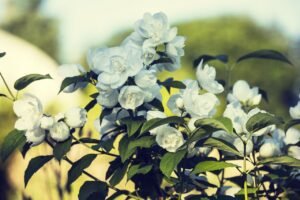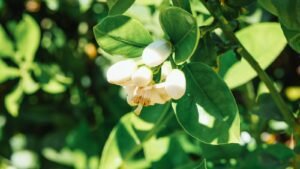Chameli Flower, also known as Jasmine, is a fragrant and beautiful flower that is popularly cultivated for ornamental purposes. Its delicate petals release a sweet, floral scent that has made it a favorite of gardeners, perfumers, and spiritual practitioners alike.
In Hindu mythology, Chameli is revered as a symbol of purity and devotion. Its sweet fragrance is said to attract the attention of the gods, and it is often used in religious ceremonies and offerings. In addition to its spiritual significance, Chameli has been used in traditional medicine to treat a variety of ailments, including anxiety, depression, and insomnia.
Chameli is a popular flower for weddings, and its delicate blooms are often used in bridal bouquets, garlands, and decorations. The flower is also used in perfumes, soaps, and other beauty products due to its pleasing aroma. You can Explore Other popular flower names which are used in weddings and beauty products including roses, orchids, peonies, and hydrangeas.
Overall, Chameli is a versatile and beloved flower that has played an important role in cultures and traditions around the world. Its a delicate beauty and enchanting scent, along with those of other popular flowers, make them true treasures of the natural world.
Chameli Flower
The scientific name of the Chameli Flower is Jasminum. this is a genus of shrubs and vines in the olive family Oleaceae. It contains around 200 species native to tropical and warm temperate regions of Eurasia, Africa, and Oceania. Jasmines are widely cultivated for the adorable characteristic fragrance of their flowers.
Types of Chameli Flower:-
1.} Common Jasmine:-

Its Scientific name is Jasminum officinale. This is one of the flowering plants in the olive family Oleaceae and is native to northern Iran, Afghanistan, Pakistan, the Himalayas, Tajikistan, India, Nepal and western China.
It is cultivated widely in many places, such as Spain, France, Italy, Portugal, and, Serbia, Algeria, Florida and the West Indies. we know it as summer jasmine, poet’s jasmine, white jasmine, true jasmine or jessamine. There are many gardeners in the world who particularly grow it for the intense fragrance of its flowers in summer.
Common Jasmine is a vigorous, twining deciduous climber with sharply pointed pinnate leaves and clusters of starry, pure white flowers in summer, which are the source of its heady scent. The leaf has 5 to 9 leaflets.
2.} White Jasmine:-

Its Scientific name is Jasminum polyanthum. we know it as the many-flowered jasmine or pink jasmine. this flower is a flowering plant in the olive family Oleaceae and is native to China and Myanmar. It is a strong evergreen twining climber, with abundant, highly fragrant pink and white flowers.
The plant can grow up to 6 metres in height with support. The compound leaves with 5 to 9 leaflets are dark green on the upper surface and lighter green beneath, with glabrous, angular branches.
3.} Royal Jasmine:-

Its Scientific name is Jasminum grandiflorum. The flower has other names like the Spanish jasmine, Royal jasmine, and Catalan jasmine. This flower native to South Asia, the Arabian peninsula, East and Northeast Africa.
It is a scrambling deciduous shrub growing to 2–4 m tall. The leaves are opposite and 5–12 cm long, pinnate with 5–11 leaflets. the individual flowers are white having a corolla with a basal tube 13–25 mm long and five lobes 13–22 mm long. The flower’s fragrance is unique and sweet.
4.} Star Jasmine:-

Its Scientific name is Jasminum multiflorum, it is a flowering plant in the olive family Oleaceae and native to India, Nepal, Bhutan, Laos, Burma, Thailand and Vietnam. Jasmine’s other species have attractive and intensely fragrant flowers, but this species does not have any scent.
In Indian mythology, Kund is known for its whiteness. Also, beautiful white teeth are often compared to Kunda buds. It is especially sacred to Vishnu. In Manipur, this flower is specially included in worship and an essential part of a marriage ceremony.
5.} Cape Jasmine:-
Its Scientific name is Gardenia jasminoides. It is an evergreen flowering plant of the coffee family Rubiaceae and native to parts of South-East Asia. Its Wild plants range from 30 centimetres to 3 metres (about 1 to 10 feet) in height. It has very dense branches with opposite leaves, gathered in groups on the same node. The flower leaves are dark green, shiny and slightly waxy surface.
because of its shiny green leaves and heavily fragrant white summer flowers, It is a house plant in temperate climates.
6.} Winter Jasmine:-

Its Scientific name is Jasminum nudiflorum, and native to China. The flower’s blossoming peaks right after winter, which is why it is also named Yingchun in Chinese, which means “the flower that welcomes Spring”. It is widely cultivated as an ornamental in France and scattered locations in the United States.
It grows to 3 m (10 ft) tall and wide, with arching green shoots and opposite, pinnate, dark green leaves. Each leaf is divided into three oval-oblong leaflets which are about 3 cm long. It is a trailing, vine-like shrub.
7.} Crape Jasmine:-

Its Scientific name is Tabernaemontana divaricata. we know it as the pinwheel flower, crape jasmine, East India rosebay and Nero’s crown. with its an evergreen shrub or small tree native to South Asia, Southeast Asia and China. In zones where it is not hardy, grown as a house/glasshouse plant for its attractive flowers and foliage. The stem exudes a milky latex when broken, whence the name milk flower.
Caring Tips For Chameli Flower Plant:-
Water should not collect in the drip tray as it will cause waterlogging of the soil. In summer Jasmine needs more water supply. From March to November fertilizer once a month. but during winter fertilizer should be avoided.
Chameli’s home remedies:-
1. treating acne, cuts, and multiple wounds and scars which we encounter throughout our day to day life. Juice of ground flowers is effective for this purpose.
2. Infusion of young leaves and roots is effective against curing gallstones and controlling diabetes.
3. Jasmine flowers are also effective in eradicating irritation and inflammation from eyes when they are used along with water to wash eyes.
The medicinal uses of the chameli plant and its parts are:
1. Flowers: Jasmine flowers are frequently used for deworming purposes. The flowers can be effective against jaundice and bacterial diseases. The buds, in fact, are effective in the treatment of ulcers, eye disorders, and many skin diseases.
2. Leaves: The leaves of the Jasmine plant are used against acne and wounds as they have antiseptic properties. The herbal tea prepared from leaves is helpful in curing cancer. The extract obtained from the leaves can stop breast cancer.
3. Jasmine is used in the preparation of perfumes and incense sticks. It is also used in the preparation of creams, soaps, and shampoos.
4. Jasmine oil is a stimulant and aphrodisiac. It is used to relax mental status and improves mental alertness.


